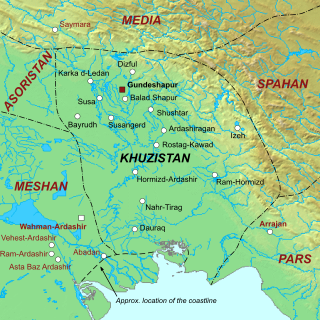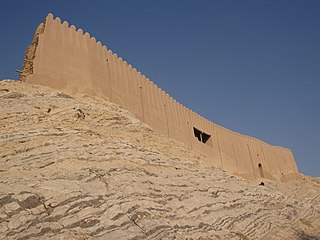
The Muslim conquest of Persia, also called the Muslim conquest of Iran, the Arab conquest of Persia, or the Arab conquest of Iran, was a major military campaign undertaken by the Rashidun Caliphate between 632 and 654. As part of the early Muslim conquests, which had begun under Muhammad in 622, it led to the fall of the Sasanian Empire and the eventual decline of Zoroastrianism, which had been predominant throughout Persia as the nation's official religion. The persecution of Zoroastrians by the early Muslims during and after this conflict prompted many of them to flee eastward to India, where they were granted refuge by various kings.

Greater Khorāsān or Khorāsān or Khurāsān is a historical eastern region in the Iranian Plateau between West and Central Asia that encompasses western Afghanistan, northeastern Iran, the eastern halves of Turkmenistan and Uzbekistan, western Tajikistan, and portions of Kyrgyzstan and Kazakhstan.

Istakhr was an ancient city in Fars province, five kilometres north of Persepolis in southwestern Iran. It flourished as the capital of the Persian Frataraka governors and Kings of Persis from the third century BC to the early 3rd century AD. It reached its apex under the Sasanian Empire, and was the hometown of the Sasanian dynasty. Istakhr briefly served as the first capital of the Sasanian Empire from 224 to 226 AD and then as principal city, region, and religious centre of the Sasanian province of Pars.

The Battle of Nahavand, also spelled Nihavand or Nahawand, was fought in 642 between the Rashidun Muslim forces under caliph Umar and Sasanian Persian armies under King Yazdegerd III. Yazdegerd escaped to the Merv area, but was unable to raise another substantial army. It was a victory for the Rashidun Caliphate and the Persians consequently lost the surrounding cities including Spahan (Isfahan).

The Muslim conquest of Khuzestan took place from 637/8 to 642, and ended with the acquisition of the rich Khuzestan Province by the Rashidun Caliphate.

Sakastan was a Sasanian province in Late Antiquity, that lay within the kust of Nemroz. The province bordered Kirman in the west, Spahan in the north west, Kushanshahr in the north east, and Turan in the south east. The governor of the province held the title of marzban. The governor also held the title of "Sakanshah" until the title was abolished in ca. 459/60.

The Battle of the Masts was a naval battle fought in 655 between the Rashidun Caliphate under the command of Abu al-A'war and the Byzantine Empire led by emperor Constans II.

The Battle of Firaz took place around January 634 between the Rashidun Caliphate and the combined armies of the Sasanian Empire and the Byzantine Empire. It ended with a Rashidun victory, concluding the first Arab invasion of Mesopotamia.

The Battle of Ullais was fought between the forces of the Rashidun Caliphate and the Sasanian Persian Empire in the middle of June 633 AD in Iraq, and is sometimes referred to as the Battle of Blood River since, as a result of the battle, there were enormous amounts of Persian Sasanian and Arab Christian casualties.

The Rashidun Caliphate was the first caliphate to succeed the Islamic prophet Muhammad. It was ruled by the first four successive caliphs of Muhammad after his death in 632 CE. During its existence, the empire was the most powerful economic, cultural, and military force in West Asia and Northeast Africa.
Abū ʿAbd al-Raḥmān ʿAbd Allāh ibn ʿĀmir ibn Kurayz was a Rashidun politician and general, he served as the governor of Basra from 647 to 656 AD during the reign of Rashidun Caliph Uthman ibn Affan. Through his father, he was a cousin of the Caliph. He is renowned for his administrative and military prowess, particularly for his successful campaigns of reconquest and pacification in the former territories of the Sasanian Empire, in what is now present-day Iran and Afghanistan.

The Battle of Sallasil, often referred to as the Battle of Chains, was the first battle fought between the Rashidun Caliphate and the Sasanian Persian Empire in April 633. The battle was fought in Kazima by the forces of Khalid ibn al-Walid and the Persians under Hormozd. It was fought soon after the Ridda Wars were over and the Arabian Peninsula was united under the authority of the Caliph Abu Bakr. Indeed, it was the first battle of the Rashidun Caliphate in which the Muslim army elected to extend its frontiers outside of Arabia, thus initiating the Arab conquests.
Al-Muthanna ibn Haritha al-Shaybani was a Muslim Arab general in the army of the Rashidun Caliphate.

The Battle of Spahan was fought between the Rashidun Caliphate and the Sasanian Empire in 642. The Arabs were victorious during the battle, where they reportedly killed the Mihran commander Shahrvaraz Jadhuyih. After the battle, the Arabs made peace with Fadhusfan, the governor of the city. According to Abu No'aym, many people were killed or enslaved after the conquest and the settlement pattern of the region changed. Isfahan capitulated by 644 after a few failed revolts and treaties for paying taxes and tributes in exchange for military protection were drawn up.
The Battle of Waj Rudh was fought in 642/643 between the Rashidun Caliphate under Nu'man, and the Sasanian Empire under the Dailamite Muta, the Parthian Farrukhzad and Isfandiyar, and the Armenian Varaztirots. The battle was fought in Waj Rudh, a village in Hamadan. The location was precisely theorized and occurred on a road junction between Hamadan and Qazvin.

The Battle of Ray was fought between the Sasanians and the Rashidun Caliphate in 651. It was also part of the rivalry between the Ispahbudhan family and the Mihran family.
The Battle of Badghis was fought in 654 between the Karen family and their Hephthalite allies against the Rashidun Caliphate.

The Arab conquest of Pars took place from 638/9 to 650/1, and ended with subjugation of the Sasanian province of Pars, also known as Fars or Persis, to the Rashidun Caliphate under Umar.

Pars was a Sasanian province in Late Antiquity, which almost corresponded to the present-day province of Fars. The province bordered Khuzestan in the west, Kirman in the east, Spahan in the north, and Mazun in the south.
Battle of Babylon was fought between the forces of Sasanian Empire and Rashidun Caliphate in 634. Muslim Arabs won the encounter to maintain their pursuit of conquering Mesopotamia. After this battle, the Arabs would go on to conquer Ctesiphon and the rest of Iraq from the Persians.














